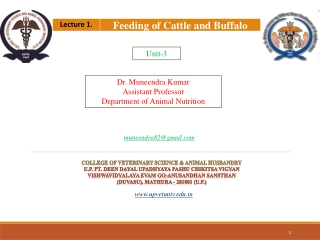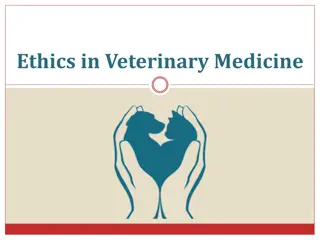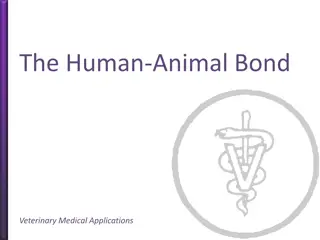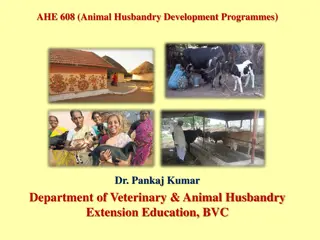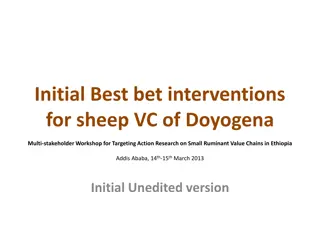Understanding Research Methodology in Veterinary and Animal Husbandry Extension
Delve into the concept, nature, and scope of research in social sciences within the context of veterinary and animal husbandry extension. Explore types of research, variables, problem formulation, hypothesis testing, and the importance of research in generating new knowledge. Discover the process of choosing a research area, defining research problems, and developing research statements in this comprehensive guide.
Download Presentation

Please find below an Image/Link to download the presentation.
The content on the website is provided AS IS for your information and personal use only. It may not be sold, licensed, or shared on other websites without obtaining consent from the author. Download presentation by click this link. If you encounter any issues during the download, it is possible that the publisher has removed the file from their server.
E N D
Presentation Transcript
AHE 606 (RESEARCH METHODOLOGY IN VETERINARY AND ANIMAL HUSBANDRY EXTENSION) Department of Veterinary & Animal Husbandry Extension Education, BVC
Topics covered Concept, nature and scope of research in social sciences. Types of research fundamental, applied and action research, experimental and non- experimental research. Variables, types and their measurement. Selection and formulation of research problem. Hypothesis importance, selection criteria (quality of workable hypothesis), formulation and testing of hypothesis.
What is Research and Why Do It ? What? Investigation of a problem in scientific manner. The systematic , rigorous investigation of a situation or problem in order to generate new knowledge or validate existing knowledge. Why? Create, have fun, play Invent, be on leading edge of discovery, be a scientist Transfer discoveries to benefit society Work in interesting and rewarding careers
Choosing a Research Area Criteria Exciting and interesting area to you Important problems in area Researcher s aptitude- visualize the problem Researchable Feasible ( research competencies, financial consideration , time requirement & administrative consideration ) Significant
Research Topic and Research Statement If there is a knowledge gap in an area that need to be investigated, the research problem identifies this gap. Where as the research topic is simply a broad area of interest, the research problem identifies what is problematic about that topic. Research Statement: A statement specifies exactly what is being studied. Ex.- Jaunpur janpad ke snatak star ke kshatro me rastriya surksha ke prati dristikon ka ek adhyayan.
Definitions of Research Problem A research problem is a discrepancy between what one knows and ought to know to solve a problem. Generally speaking , a problem exists when there is no available answer to some question. A problem is a interrogative statement that asks- what relation exists between two or more variables. A situation or circumstance that requires a solution to be described, explained, or predicted. It is an unsatisfactory situation that wants you to confront.
Where do research questions come from? Develop an idea Select a general area- Where do research questions come from? Observations From theory Review of literature Creativity Historical facts Suggestion for further research Serendipity Consideration of existing practices and needs- why & how ? Take courses, attend seminars Talk to professors, visitors, other students Learn about yourself, what you like, etc. Solve some research problems
Review of literature There may be areas , as revealed by a dearth of available literature on the topic that remain unexplored. Review of literature will also help to identify what is known and what is not known about the research problem. Therefore, the research problem could be specified and stated at this point.
From prior researches Continuing research lines a related series of studies Replications & extensions No study can stand by itself, must be replicated for confidence in the results Types of replications Direct replication exact replication. Purpose is to determine reliability: Reliability = how consistent or replicable are the research findings? Systematic replication (extension) at least one aspect of the study is different, e.g., different subject population, setting, variations in the independent variable, etc.
Creativity Creativity using your imagination to find new ways to answer questions. Elements of Creativity- Novelty or originality- uncommon Fluency-how many Flexibility-how many types Elaboration
Suggestion for further research Every research report suggests areas for continued study
Kinds of the problem Philosophical Problems Historical Problems Survey type Problems Theoretical Problems Practical Problems Co relational Problems Experimental Problems
Writing the statement of the research problem A Well said problem is half done. Follow the rules while writing research problem: should be pin pointed not ambiguous should be clear and understandable define key words
The problem statement could be done in two forms: Declarative: The relationship between the nurses job satisfaction and tendency to leave work Interrogative: Is there a relationship between the nurses job satisfaction and tendency to leave work?
Thanks Thanks .. ..



